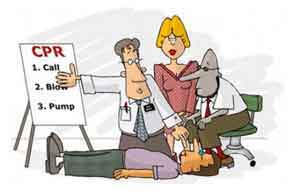Video-Based CPR Training May be as Valuable as Hands-On Approach
Largest CPR Training Trial for Families of At-Risk Patients Shows Success of Low-Cost Teaching Method
- Video-Based CPR Training May be as Valuable as Hands-On Approach, Penn Study Finds
- Largest CPR Training Trial for Families of At-Risk Patients Shows Success of Low-Cost Teaching Method
 Using a video to train family members of patients at risk for cardiac arrest in CPR may be just as effective as using the traditional hands-on method with a manikin, according to new research from the Perelman School of Medicine at the University of Pennsylvania. The findings suggest simplified and more cost-effective approaches may be useful for disseminating CPR education to families of at-risk patients and the general public. The results are being presented during the American Heart Association Scientific Sessions 2015.
Using a video to train family members of patients at risk for cardiac arrest in CPR may be just as effective as using the traditional hands-on method with a manikin, according to new research from the Perelman School of Medicine at the University of Pennsylvania. The findings suggest simplified and more cost-effective approaches may be useful for disseminating CPR education to families of at-risk patients and the general public. The results are being presented during the American Heart Association Scientific Sessions 2015.
Less than 40 percent of cardiac arrests in the United States are treated by CPR delivered by bystanders, a fact which has prompted calls for improved CPR education to empower the public to take action. While some studies have suggested that using a video self-instruction (VSI) kit including a small inflatable manikin is helpful in remembering the basics of the technique, the cost of such kits is often prohibitive. Further, since kits require use of a manikin, they are limited in their use compared to video-only approaches which can be used to train larger groups.
“Most cardiac arrests take place in the home, where a patient’s best chance of survival is having a family member who knows and can properly administer CPR,” said the new study’s lead author, Audrey L. Blewer, MPH, assistant director for Educational Programs in Penn’s Center for Resuscitation Science, who will present the results. “Traditional training classes involve several hours of group classes and can cost upwards of $100 or more per person. These classes are more commonly used by health professionals, lifeguards and people in other professions where mastery of CPR and certification are necessary. What the new study shows is that for the general public, where cost and time may be more of a concern, using only video instruction may be just as helpful in teaching the basics of CPR as using a hands-on method.”
In the study, more than 1,600 family members of patients identified as being at-risk for a cardiac arrest across eight hospitals were trained in CPR using either the video-only method, or the VSI with manikin. Six months after training, researchers tested participants to evaluate their long-term retention of properly performing CPR. Results indicated that while there were small differences in the depth of chest compressions among the groups, the overall ability to properly perform CPR was similar. Recent research also suggests the difference in compression depth may be insignificant to a patient’s chance of survival.
“The study has great potential for helping to increase the opportunity for CPR education among the public, and especially for groups of people who may not have access to training programs otherwise,” said senior author, Benjamin S. Abella, MD, MPhil, an associate professor of Emergency Medicine and clinical research director of the Center for Resuscitation Science at Penn Medicine. “Knowing that the manikin may not be necessary for basic training, we could conceivably show CPR training videos in public places, such as a doctor’s waiting room or at the DMV, and they will actually be beneficial in providing this life-saving skill.”
Source Newsroom: Perelman School of Medicine at the University of Pennsylvania
Citations
American Heart Association Scientific Sessions 2015

